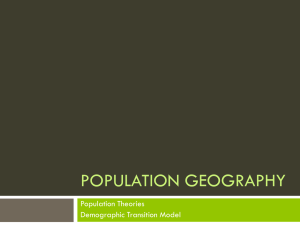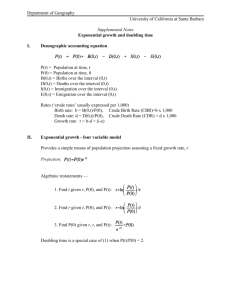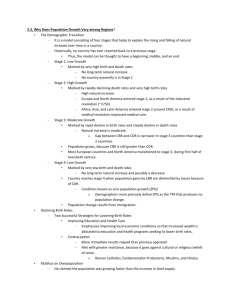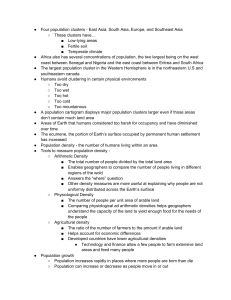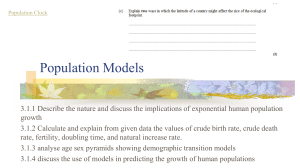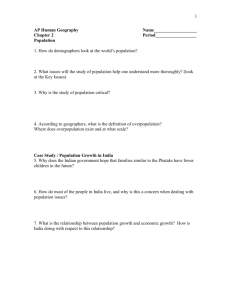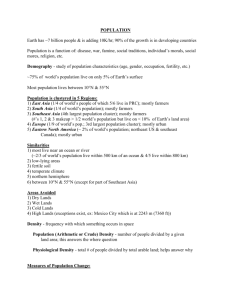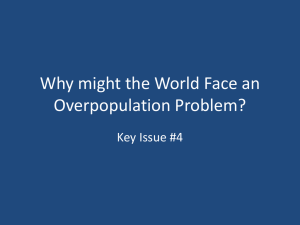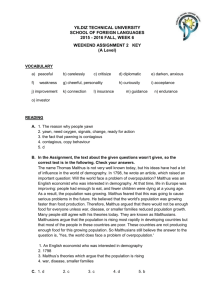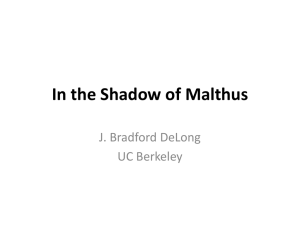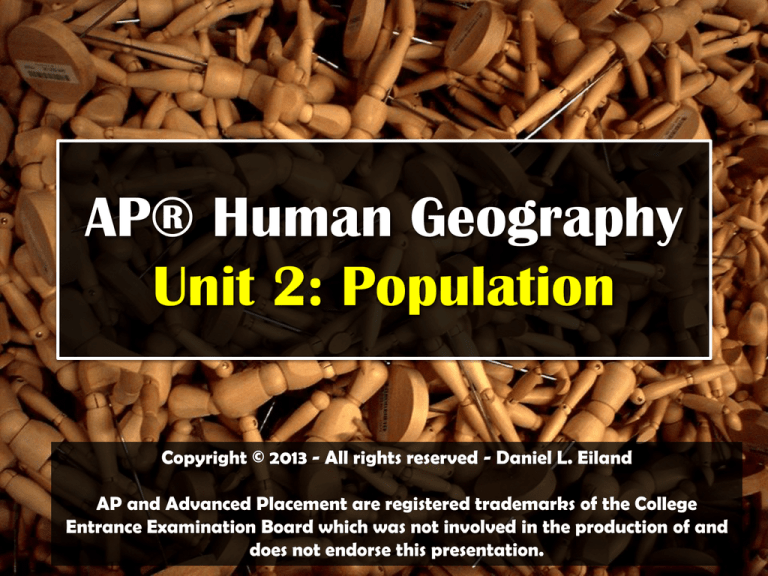
AP® Human Geography
Unit 2: Population
Copyright © 2013 - All rights reserved - Daniel L. Eiland
AP and Advanced Placement are registered trademarks of the College
Entrance Examination Board which was not involved in the production of and
does not endorse this presentation.
Overview
Population
Unit 2
Migration
Part 1: Population
Where is
Everyone?
Overpopulation
Sections
Why is
population
increasing at
different rates?
Where has
population
increased?
Section 1: Where Is Everyone?
What is demography?
Create your own definition:
Demos (Greek for “People”) + graphe (Greek
for “to describe”)
What is population
distribution?
“Population distributions are
descriptions of locations on
the Earth’s surface where
individuals or groups live.”
In what places on Earth do you expect to find the
most people living?
What common traits might these places exhibit?
What is ecumene?
“Ecumene is the portion of
the Earth’s surface occupied
by permanent human
settlement.”
Common Traits of Ecumene
Almost 90% of all
people live north of the
equator.
More than half of all
people live on about
5% of the land, and
almost nine-tenths on
less than 20%.
Most people live in
areas close to sea level.
About two-thirds of
world population is
concentrated within
300 miles of the ocean.
How do you
measure
population?
“You measure population by
looking at Population Density;
the number of people
occupying an area of land.”
Arithmetic Density
• The total number of people in an area.
• Population divided by Land Area
Physiological Density
• The number of people supported by a unit area of arable
land.
• Provides insights into the relationship between the size of
a population and the availability of resources in a region.
Agricultural Density
• The ratio of the number of farmers to the amount of
arable land.
Discuss how the agricultural density of the United
States may have changed over the last 200 years.
Two-thirds of the World’s Population is
concentrated in four specific areas.
East Asia
China, Japan, the Korean Peninsula, and Taiwan
South Asia
India, Pakistan, Bangladesh, Sri Lanka
Southeast Asia
The islands of Java, Sumatra, Borneo, Papua New Guinea, Philippines,
Indonesia
Europe
Largely concentrated in urban areas.
Section 2: Where has the World’s
population increased?
How do you
measure population
change?
“You can measure population
change through the Crude
Birth Rate, the Crude Death
Rate, and the Natural
Increase Rate.”
The Crude Birth Rate (CBR) is the total
number of live births a year for every 1,000
people alive in the society.
The Crude Death Rate (CDR) is the total
number of deaths a year for every 1,000
people alive in the society.
The Natural Increase Rate (NIR) is the
percentage by which a population grows in a
year.
NIR = (Crude birth rate − Crude death rate) / 10
The Total Fertility Rate(TFR) is the average
number of children a woman will have during
her childbearing years.
The Infant Mortality Rate (IMR) is the
annual number of deaths of infants under 1
year compared with total live births.
Life Expectancy measures the average
number of years a newborn can expect to
live at current morbidity levels.
Section 3: Why is population increasing
at different rates in different places?
What allowed the population to grow so
quickly from 1750 C.E. – 2000 C.E.?
What is the
doubling rate?
“The doubling rate is the amount of
time it takes to double a
population.”
Timeline of Population Growth
1750 C.E.
• The Industrial
Revolution
• Doubling Rate
decreases
because of
technology.
Start of Human
History
• Natural Increase
close to 0
1950s C.E.
• Doubling Rate
begins to
decrease.
8,000 B.C.E.
1850 C.E.
• The Neolithic
(Agricultural)
Revolution
• Doubling Rate
decreases
because of food.
• The Medical
Revolution
• Doubling Rate
decreases
because less
developed
countries begin to
get medicines.
What are some reasons that the doubling
rate began to decrease in the 1950s?
What is the
demographic
transition model?
“The Demographic Transition
Model explains the transition from
high birth and death rates to low
birth and death rates as a country
develops from a pre-industrial to an
post-industrial economic system.
Stage 1:
Low
Population
Growth
Stage 2:
High
Population
Growth
Stage 3:
Moderate
Population
Growth
Stage 4:
Low
Population
Growth
Stage 5:
Declining
Population
Growth
What is a
population
pyramid?
“A population pyramid is a graphical
illustration that shows the
distribution of various age groups as
well as the sex ratio, the number of
males per hundred females and the
dependency ratio, the number of
people who are too old or too
young to work.
What are some population characteristics of Sudan’s population?
What does this tell you about the country?
Stage 1: Low Growth
1.People depended on hunting and gathering
for food.
2.Most of human history spent during this
stage.
3.The NIR is essentially zero.
4.There is no country still in stage 1.
Stage 2: High Growth
1. Brought about by the Industrial Revolution.
2. CDR Plummets while the CBR remains the
same as in stage 1.
3. Allowed to spread to LDRs by the medical
revolution (20th century)
Stage 3: Moderate Growth
1. Brought about by cultural changes.
2. Characterized by a sudden drop in the CBR.
3. There is still growth but not as fast as in Stage 2
Stage 4: Declining Growth
1. The CBR = CDR
2. Brought about by an aging population,
education, and family planning
3. Zero Population Growth
4. Low TFR
Stage 5: Negative Growth
1.CDR > CBR because of an aging population.
2.NIR is less than Zero.
3. Much of Europe is entering this stage.
The following 5 slides are population
pyramids of different areas on earth.
Determine what stage they are in by
how they look.
The United States of America
Bolivia
The Russian Federation
Australia
Central America
Predicting Growth
To determine how much a population will grow,
geographers use the demographic accounting
equation:
Where
P = Population, B = Births, D = Deaths,
I = Immigration, E = Emigration, t = Time Now,
t + 1 = some time in the future
Economic
Development
Public Policy
Education
What
affects
population
growth?
Cultural
Traditions
Gender
Empowerment
Healthcare
What is the
Epidemiologic
Transition Model?
“The Epidemiologic Transition
Model focuses on distinctive causes
of death in each stage of the
demographic transition.”
Stage 1
• The stage of Pestilence and Famine
• Example: The Black Death
Stage 2
• The stage of receding Pandemics
• Example: Cholera
Stage 3
• The stage of degenerative and human-created diseases
• Examples: Cancer and Cardiovascular Disease
Stage 4
• The stage of delayed degenerative diseases
• Example: Cancer and disease is slowed or stopped by medical advances.
Stage 5 (Possible)
• Reemergence of infectious and parasitic diseases.
• Reasons: Evolution, Poverty, Improved Travel
Section 4: Overpopulation and
Population Control
Are we becoming
overpopulated?
How would you define overpopulation?
My theory is that population will
eventually outpace food production.
While population increases
geometrically, food supply increases
arithmetically.
Thomas Malthus
Thomas Malthus’ Theory
Malthus Supporters (neoMalthusians) Argue:
• The growth of less developed countries are
outstripping even Malthus’ predictions.
• World population is not just stripping food but
a lot of other resources as well.
• To fix the problem continue programs for
population limitation such as birth control and
family planning.
Malthus Critics Argue:
• Malthus’ theory is based on a belief that the
increase in the world’s food supply is fixed
rather than expanding.
– An increase in technology and genetic food
production has increased the amount of available
food.
• A larger population stimulates economic
growth to produce greater resources.
Who is right? The
Neo-Malthusians or
Malthus’ Critics?
Food is increasing more rapidly than predicted by
Malthus.
Birth Rates are declining and the NIR is
dropping.
Explain the Following Quote:
“World food production capacity is not
(yet) the problem. . . Rather, the ongoing
quandary is the distribution of that food
and the ability of poorer nations to
purchase and allocate it to their people.”
Why are birth rates
declining?
Contraceptive
Use
Women’s
Rights
Population
Growth
Decline
Government
Policy
Education
Percentage of Women using Modern Day
Contraceptive Methods
The Gender Equity Index shows the disparity
between the rights of men and women.
There is a link between education levels and the
number of children had per family.
Discuss: Do you think that we will ever
reach a point of zero population growth
worldwide? Why or why not.
What is the difference
between expansive and
restrictive population
policies??
“Expansive population policies are
governmental policies that seek to
increase the rate of natural
increase while Restrictive
population policies seek to reduce
the rate of natural increase.”
A Case for an Expansive Population Policy:
The Russian Federation
What has happened to Russia’s population since
the 1990s?
At what point did Russia’s population begin to
decrease drastically? Increase again?
Predict: What might be the results of
having too few people in your country?
Discuss: If you were Russia’s leader,
what policies might you put in place to
increase population?
Cash
Incentives
for Children
Russia’s
Population
Policies
(2006)
Immigration
Incentives
The “Day of
Conception”
A Case for an Restrictive Population Policy:
The People’s Republic of China
Compare China’s population growth to that of
Russia.
Benefits
Given to
Families
with 1 Child
China’s One
Child Policy
More
successful
in Urban
areas
A fine
imposed for
additional
children
Would you consider the One Child Policy
effective? Why or Why not?
Predict: What might be the results of
limiting population growth?

